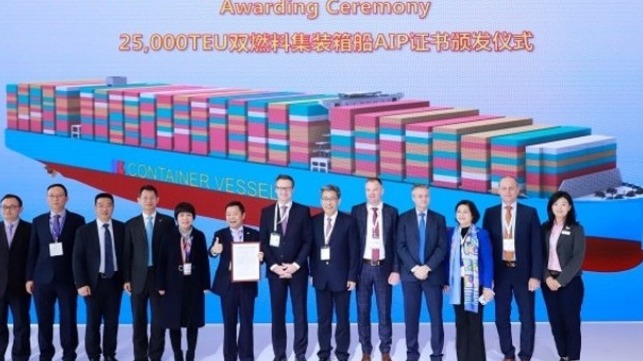Marintec Ship Design Approvals Feature LNG and Ammonia

DNV GL has granted approval in principle to Hudong-Zhonghua Shipbuilding for its new LNG-fueled 25,000-TEU container ship - a design that would be the largest container ship in the world.
Knut Ørbeck-Nilssen, CEO DNV GL – Maritime, presented the certificate to Chen Jun, President of Hudong-Zhonghua at Marintec China trade fair last week.
DNV GL and Hudong-Zhonghua have cooperated other projects including the Hapag Lloyd vessel Sajir, the world’s first LNG conversion of a large container ship. In addition, in 2015, Hudong-Zhonghua developed a B type tank design and mock-up and obtained a GASA certification from DNV GL. DNV GL is also providing support on the application of the Type B tank in new container ship designs.
Also at Marintec, DNV GL entered into a joint development project with Huangpu-Wenchong Shipbuilding Company on a 5,000 TEU LNG dual-fuel container ship. The new energy-efficient 5,000 TEU Panamax container ship is designed for the fast-growing intra-Asia trades. The vessel will have an hydrodynamically optimized low resistance ship line, a more effective structural design and enhanced ergonomic design features for greater crew comfort.
Ammonia-Fuelled 23,000-TEU Container Ship
Also at Marintec, Lloyd’s Register (LR) granted approval in principle to Dalian Shipbuilding Industry Co. (DSIC), and MAN Energy Solutions for an ammonia-fuelled 23,000 TEU ultra-large container ship concept design, the first ammonia as fuel design of its kind in China.
Bjarne Foldager, Senior Vice President, Head of Two-Stroke Business at MAN Energy Solutions, says that ammonia has the potential in the future to be created from renewable, primary-energy sources such as wind, hydro or solar. Ammonia, when generated by renewable energy sources, has no carbon footprint and emits almost no CO2, SOx or particulate matter when burned in engines.
LR has also granted approval in principle to China Merchants Energy Shipping, CNOOC Gas and Power Group, DSIC and GTT for an LNG-fuelled VLCC design that uses a prismatic GTT Mark III membrane LNG tank.
Ammonia-Fuelled Container Feeder
ABS announced at Marintec that it will advise on compliance and safety considerations as MAN Energy Solutions (MAN) and the Shanghai Merchant Ship Design & Research Institute (SDARI) develop designs for an ammonia-fuelled Chittagongmax 2,700 TEUs container feeder ship.
SDARI will develop the ship design and engineering, which will utilize MAN’s dual fuel technology and ABS will assess safety-related issues and contribute to the development of rules and standards in relation to ammonia as a fuel.
LNG Bunkering Vessel
Bureau Veritas Marine & Offshore granted approval in principle to the innovative design for a 19,000 cbm LNG bunkering vessel with a GTT membrane type tank - the Quadelprop - at Marintec. The name Quadelprop reflects features in the design and propulsion arrangements to enable high maneuverability and station keeping: four azimuth thrusters fitted at each corner of the hull and four dual fuel generator sets installed in the engine room compartment and complemented by an energy storage system provide power to the ship and in particular to the electric thruster motors. The azimuth capability is enhanced and controlled by a redundant dynamic positioning (DP) system
The high precision of the design’s DP system allows Quadelprop to keep position relative to the client ship so that the LNG transfer system is always within a safe working envelope. Ship-to-ship LNG bunkering operations can also be envisaged safely at anchorage and in waiting areas. The absence of mooring requirements is expected to simply and shorten the duration of the bunkering operation and also allow the bunker ship to immediately move away from the client ship in case of an emergency shut down and disconnection of transfer hoses.
Two LNG bunkering manifolds are provided: at amidships, portside, with large diameter connections allowing a max transfer flow rate of 2,000 m3/h and a stern bunkering manifold with smaller diameters allowing a transfer flow rate of 250 m3/h. The starboard side amidships manifold is dedicated to LNG loading at terminal and is designed for high loading flow rate.
Bespoke technical consultancy Marinnov developed the design with engineering support from ship designer Marine Assistance. The ship is designed to carry LNG, under a maximum pressure of 0.7 barg in two identical membrane-type tanks. The work has involved a close collaboration with GTT and Air Liquide. The vessel will feature a full B/5 wide double hull protecting the cargo tanks area and the engine room as well as a full redundancy of main and auxiliary equipment required by the Bureau Veritas DP2 notation.
